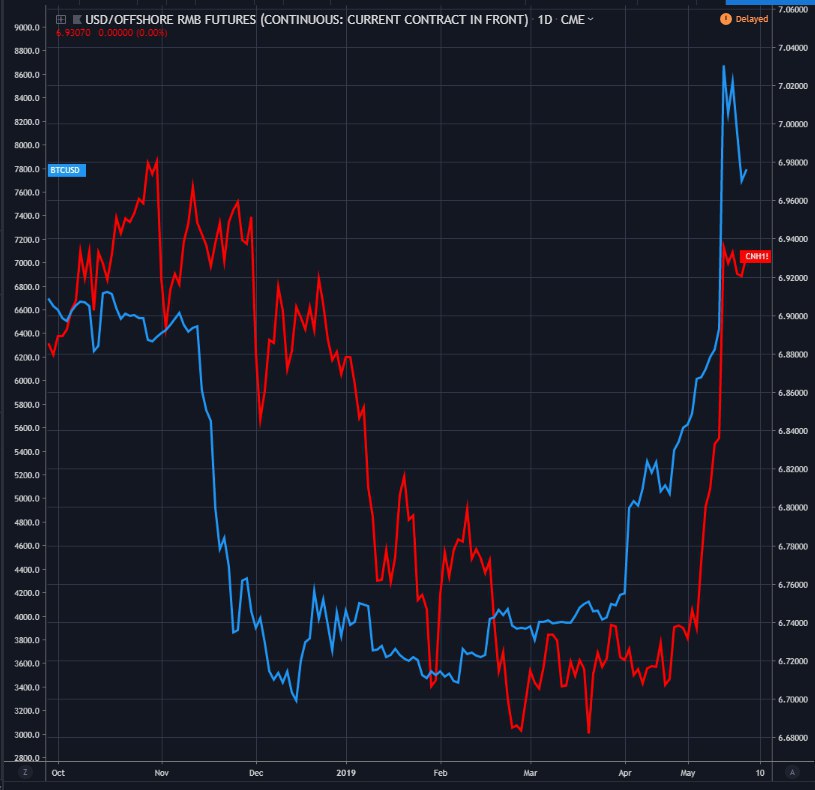Latest news about Bitcoin and all cryptocurrencies. Your daily crypto news habit.

Bitcoin’s price has seen a dramatic resurgence of bullish support over 2019, which has allowed it to decouple away from a vast majority of traditional financial markets. But when we compare its performance to the Offshore RMB Futures market, however, we can see a striking resemblance between the two trends. Let’s take a look.
What is the Offshore Renminbi Market Exactly?
Renminbi (RMB) in Mandarin translates to ‘the people’s currency’, and has been officially recognized as the currency of the People’s Bank of China (PBoC) since 1948. The Chinese Yuan (CNY) is actually the unit of account for RMB and is not its own separate currency. The Offshore Renminbi (RMB) market itself is a non-mainland China exchange setup originally in Hong Kong to facilitate extraterritorial trade with foreign countries. Since its inception 2003, three additional offshore RMB markets have cropped up in London, Singapore, and Taiwan. But what’s the point? Well, by having a detached offshore market, China is able to keep its nation’s capital separate from foreign investments. This is important because not only does it safeguard the Chinese economy from recession if the world trade markets decline, but it also allows them to expand the reach of their currency to the global market.
Bitcoin vs. Offshore RMB Futures Performance
 Looking at the chart above, we can see the price performance of both Bitcoin (BTC) and the offshore RMB futures market over the last 8 months (blue and red lines respectively). What’s surprising here, is that we can see a very clear correlation between the two trends despite both financial products – if you can even class Bitcoin as a financial ‘product’ – operating in two entirely different spheres. When Bitcoin’s price 00 plummeted during the Bitcoin Cash ‘hash war’ in November last year, we can see that the offshore renminbi futures market followed the same steep downtrend almost exactly a month later.
Looking at the chart above, we can see the price performance of both Bitcoin (BTC) and the offshore RMB futures market over the last 8 months (blue and red lines respectively). What’s surprising here, is that we can see a very clear correlation between the two trends despite both financial products – if you can even class Bitcoin as a financial ‘product’ – operating in two entirely different spheres. When Bitcoin’s price 00 plummeted during the Bitcoin Cash ‘hash war’ in November last year, we can see that the offshore renminbi futures market followed the same steep downtrend almost exactly a month later.
Weird, right? The same similarity can be also seen when Bitcoin’s price made a strong recovery out of the bear market around April this year, only to be followed a month later by the RMB futures market again.
 What’s more, is that when we look at the most recent data on the chart, we can see that the RMB futures market now appears to have finally caught up with Bitcoin’s performance as both begin to correct at the exact same time.
What’s more, is that when we look at the most recent data on the chart, we can see that the RMB futures market now appears to have finally caught up with Bitcoin’s performance as both begin to correct at the exact same time.
Correlation, Coincidence or Something More?
What we can draw from this, is that it definitely seemed that Bitcoin was front running the offshore RMB market for a number of months. It could’ve been that the two markets had become intrinsically linked because the vast majority of investors in the RMB futures market, were also trading in the BTC market – which is quite possible given the popularity of Bitcoin across the Asian markets. Once the Bitcoin market started to suffer in November, investors started to lose money. It’s likely that the bearish sentiment could’ve seeped across into the offshore RMB futures market and caused investors to exit until the global markets stabilized. The same can be said for when Bitcoin began to recover after the crash. The renewed bullish sentiment in the crypto market could very well have encouraged RMB futures traders to return to the market – hence the spike in trades thereafter. What do you think about this interesting correlation? Let’s us know in the comment section below!
Images via Shutterstock, CME
Disclaimer
The views and opinions expressed in this article are solely those of the authors and do not reflect the views of Bitcoin Insider. Every investment and trading move involves risk - this is especially true for cryptocurrencies given their volatility. We strongly advise our readers to conduct their own research when making a decision.